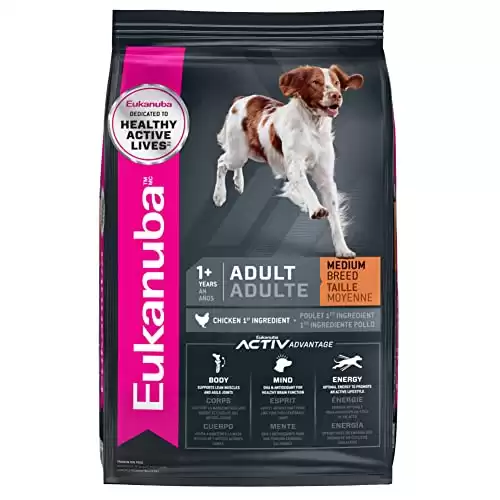West Siberian Laika
Canis lupus familiaris
Advertisement
West Siberian Laika Facts
- Prey
- Small game such as rabbits and birds
- Group Behavior
- Pack
- Temperament
- Loyal, energetic, protective, and versatile
- Training
- Highly intelligent and easy to train
- Diet
- Omnivore
- Average Litter Size
- Three to seven puppies
- Favorite Food
- Raw meat and fish
- Common Name
- Zapadno-Sibirskaia Laika or West Siberian Laika
- Origin
- North Ural and West Siberia
- Location
- Siberia Russia
West Siberian Laika Physical Characteristics
- Color
- Red
- Black
- White
- Light Grey
- Dark Grey
- Skin Type
- Fur
- Lifespan
- 12 to 15 years
- Weight
- West Siberian Laika males measure between 21 and 24 inches, and females have a height between 20 and 23 inches.
- Aggression
- Medium
West Siberian Laika as a Pet:
- General Health
- Energy Level
- Shedability
- Trainability
- Intelligence
- Tendency to Chew
- Size
- Family and kid friendliness
- Yappiness / Barking
- Low
- Separation Anxiety
- Moderate
- Preferred Temperature
- Cold climate
- Exercise Needs
- High
- Friendly With Other Dogs
- Poor
- Pure bred cost to own
- $600 to $800
- Dog group
- Hound
- Male weight
- 40-49 lbs
- Female weight
- 40-49 lbs
This post may contain affiliate links to our partners like Chewy, Amazon, and others. Purchasing through these helps us further the A-Z Animals mission to educate about the world's species.
View all of the West Siberian Laika images!
Although it’s quite the mouthful, the West Siberian Laika is also called the Zapadno-Sibirskaia Laika because of its Russian origin!
Introduction
West Siberian Laikas were originally used as farm dogs by aboriginal people living in the outlying parts of Russia until they were recognized for their hunting ability. Part of the Spitz family of dogs, with wolves as their ancestors, they use their bark to find small game and birds when hunting. The breed derives from West Siberia and North Ural, so it’s no surprise that their name originates from the Russian language. The word liaka comes from the Russian verb layat, meaning to bark.
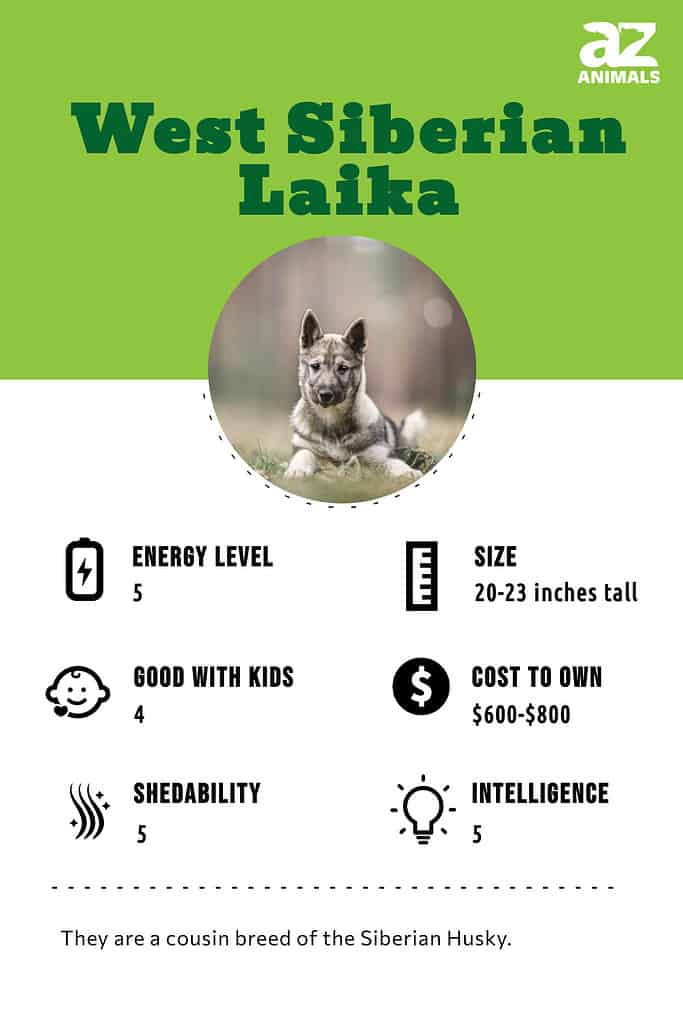
The 3 Other Types Of Laikas
Karel Laika
The Karel Laika is a breed that used to be identified alongside the Finnish Spitz. Over time, however, Karel Laikas were recognized as their own distinct breed. Karel Laikas are the perfect dog for hunting small game. They are the smallest Laika breed and have a red coat. Although beautiful, their coat causes them to be confused with foxes, meaning hunters may accidentally hunt Karel Laikas.
Russian European Laika
Russian European Laikas are a medium-sized Laika breed and are known for their success in hunting. They can hunt both large and small game, making them both adaptable and unique in their ability. Russian European Laikas are known to be more aggressive on the hunt than other Laika breeds. They have a black and white coat, and some experts believe they are related to the Finnish Bear Dog.
East Siberian Laika
East Siberian Laikas are the largest Laika breed and have a black, pale brown, or gray coat. Their coat color configuration makes them look like wolves. East Siberian Laikas originate east of Baikal Lake in Russia, and they are used for hunting and some laborious tasks.
The Best Dog Food For The West Siberian Laika
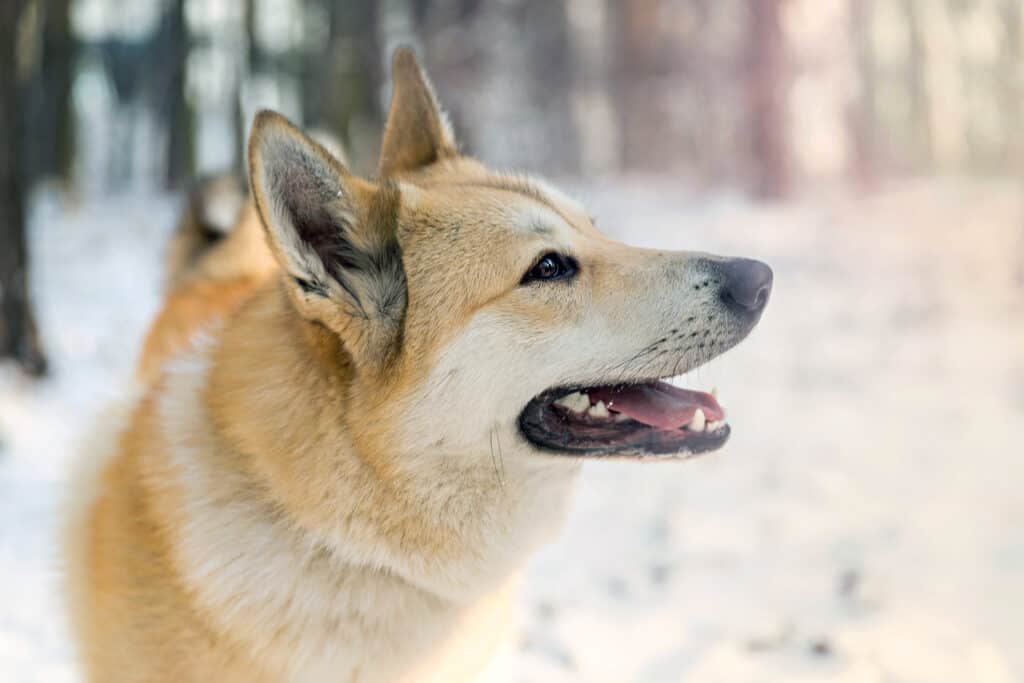
The best diet for a West Siberian Laika is a raw diet.
©iStock.com/fotyma
A raw diet is the best diet for a West Siberian Laika. They prefer meat, such as chicken or beef, and fish. When feeding a raw diet to this breed, their weight must be considered. It is recommended that for every 2.2 pounds that the dog weighs, they should be fed 0.35 to 0.88 ounces of meat and fish depending on how often they hunt, work, and play. Their portions should consist of 1/3 fish and 2/3 meat. As a pet, two meals a day should suffice. If the dog hunts and works often, three to four meals a day is recommended.
Keeping up with a raw diet for the West Siberian Laika can be difficult. Luckily, other premium dry foods will suffice in place of a raw diet. Dry foods with the main ingredients of pork, chicken, or beef are the products that should be considered first. These dogs also require plenty of protein, so at least 25% of the dry food should consist of protein. The grain amount within the dry food should be as low as possible. A-Z Animals recommends Eukanuba Adult Medium or Large Breed Dry Dog Food in the Chicken flavor. This dog food names chicken as the first ingredient and includes fiber and probiotics for healthy digestion. In addition, Eukanuba dog food helps maintain brain function for the West Siberian Laika and keeps them energized throughout the day.
- Chicken flavor
- Rich in fiber
- Probiotics aid digestion
- Good for brain function
Owning A West Siberian Laika: 3 Pros And Cons
| Pros | Cons |
|---|---|
| Protective and loyal West Siberian Laikas are protective of their family and loyal to their owners, making them fantastic companions. | Can engage in aggressive and destructive behavior West Siberian Laikas that don’t receive enough exercise, become easily jealous, or are provoked can become agitated. They may bark at strangers or other dog breeds or chew, dig, and bite. |
| An intelligent breed West Siberian Laikas are extremely intelligent, making them a pleasure to train or hunt with. | Susceptible to several health problems West Siberian Laikas and their puppies can have a host of health problems if they are not vaccinated or do not attend regular veterinary checkups. |
| Don’t need to bathe often Although regular brushing is required, West Siberian Laikas only need to bathe a few times a year. | Not friendly with other dogs West Siberian Laikas want to defend their territory and assert their dominance, meaning they are not very friendly with other dog breeds. |
Size And Weight
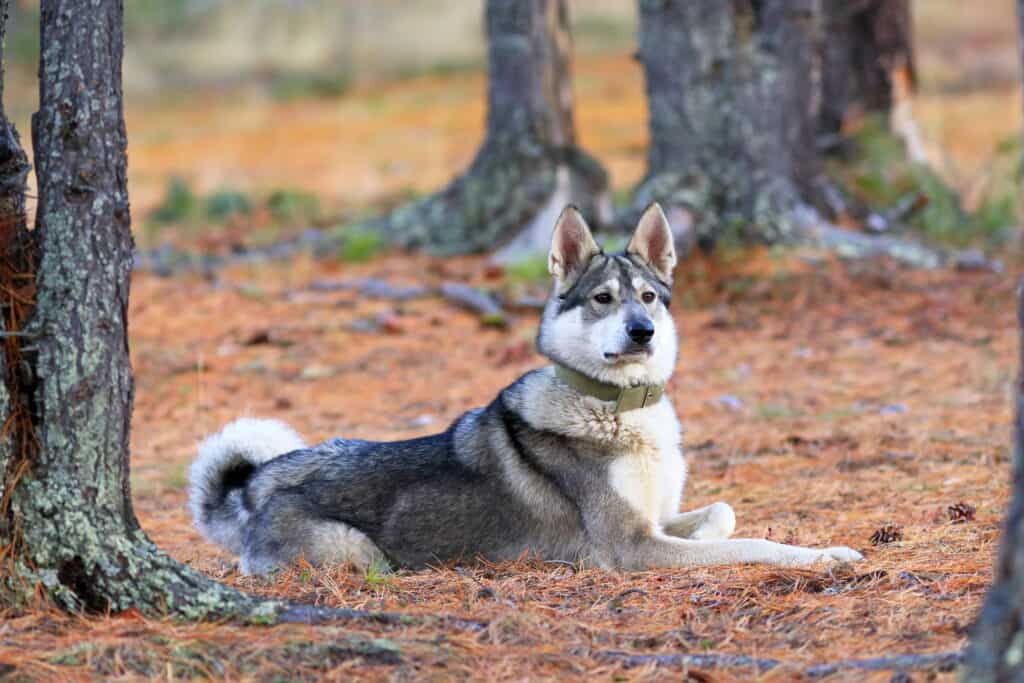
West Siberian Laikas are a medium-to-large-sized breed.
©Grigorii Pisotsckii/Shutterstock.com
West Siberian Laikas are medium to large-sized dogs that weigh between 40 and 49 pounds. Males measure between 21 and 24 inches, and females have a height between 20 and 23 inches.
Common Health Issues
West Siberian Laikas are generally known to be a healthy breed, but they still struggle with several health issues. Umbilical hernias can occur in puppies. If the umbilical ring does not close completely after birth, a swelling hernia will appear under the skin. Cryptorchidism can also affect male puppies. When one or both testicles do not descend to the scrotum, cryptorchidism occurs.
Common health issues in other breeds can occur in West Siberian Laikas as well. For instance, bloating happens in larger dogs, which, if left untreated, threatens to asphyxiate their internal organs. Hip or elbow dysplasia can cause joint discomfort, arthritis, and even the inability to walk. To avoid hip and elbow dysplasia, regular exercise and reasonable food portions should be considered. Other common issues like halitosis, periodontal disease, heartworms, and intestinal worms are preventable but possible to appear in this breed. Certain eye and heart diseases can affect any breed of dog, including the West Siberian Laika. Annual or twice-yearly checkups scheduled with a veterinarian can help prevent health issues or mitigate their effects on the dog. Therefore, the most common health issues in this breed are as follows:
- Umbilical hernia
- Cryptorchidism
- Hip dysplasia
- Elbow dysplasia
- Bloating
- Eye disease
- Heart disease
- Heartworms
- Halitosis
- Periodontal Disease
- Intestinal worms
Temperament And Behavior
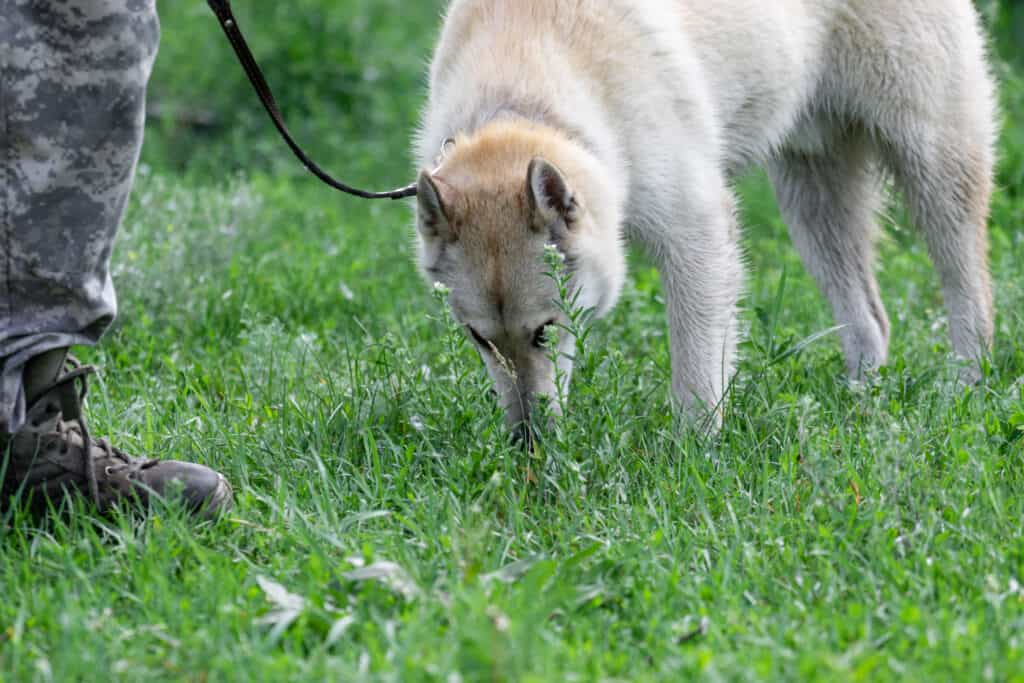
West Siberian Laikas need to release their energy through hunting or playing or they can resort to aggressive or destructive behavior.
©iStock.com/K64End
Although they bark to locate animals to hunt, West Siberian Laikas are relatively quiet dogs. A highly alert dog, they will bark at strangers as a warning, but they may engage in aggressive behavior if these strangers do not heed their signal. They have an affectionate and loyal personality and are protective of their family although they need plenty of exercise. If they do not release their energy through hunting or playing often, they can resort to aggressive and destructive behavior. They might attempt to bark, dig, or chew if they become bored and aren’t exercised properly. A part of their trait of protectiveness, they do not get along well with unfamiliar dogs because they want to defend their territory and assert dominance. As a hunting dog, West Siberian Laikas might attack small animals that are not considered game. Therefore, its crucial to keep these dogs in a large, enclosed space outside.
How To Take Care Of West Siberian Laikas
This pet needs a lot of engagement as both a puppy and an adult. They shed often and love being outside, so proper grooming is necessary for their health and happiness. In addition, West Siberian Laikas are energetic by nature and need plenty of exercise to release a mountain of energy. Inexperienced or busy dog owners should start off raising another breed of dog because this breed requires time and energy daily.
Maintenance And Grooming

West Siberian Laikas only need to be bathed a few times a year, or as needed.
©Eudyptula/Shutterstock.com
West Siberian Laikas should be brushed once or twice a week to decrease shedding, untangle their coats, and identify or expel fleas and ticks. If they begin to shed often and copiously, they should be brushed daily. They do not need to be bathed but a few times a year. However, their nails, ears, and teeth should be trimmed, cleaned, and brushed, respectively, weekly at home. Brushing their teeth can reduce the chances of halitosis or periodontal disease in this breed.
Training
West Siberian Laikas are extremely intelligent dogs, so training should be an easy process. It is crucial to be kind and gentle in training them. Negative or frustrated responses aimed at this breed may cause them to become discouraged or agitated.
Exercise
West Siberian Laikas require a large amount of exercise, or they will become restless and destructive. Runs, walks, and hikes are a viable way to release pent-up energy in this breed. They should also be allowed to run freely in a large, enclosed yard. Bred and born hunters, locating and catching game is the best form of exercise for West Siberian Laikas.
Puppies
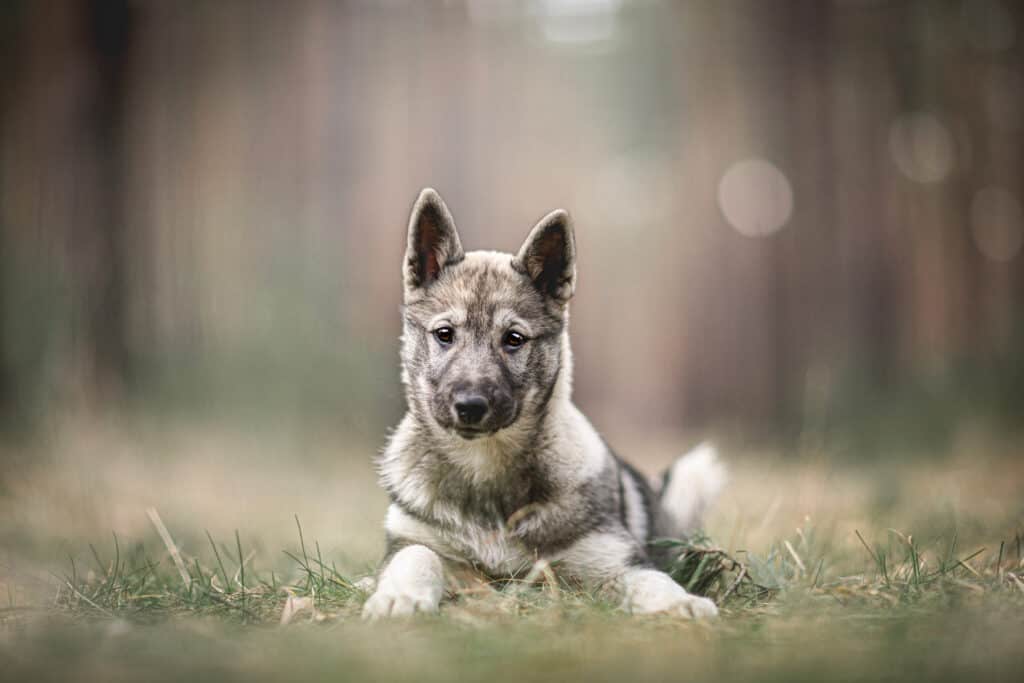
While this is an adorable West Siberian Laika puppy, full-grown, these dogs grow to be between 40-49 pounds.
©nik174/Shutterstock.com
West Siberian Laika puppies are prone to problems like umbilical hernia and cryptorchidism, so veterinary consultation is necessary when beginning to raise these pups. Vaccinations for puppies should be considered to decrease the chances of disease, and they should be spayed and neutered before six months of age. In addition, they should begin socialization programs at approximately eight or nine weeks old so that their likelihood of showing aggressive behavior to other breeds decreases. Puppies also need lots of exercise daily and should be trained from a young age to ensure obedience and dispel the possibility of erratic or aggressive behavior later in life.
Puppies between eight and 12 weeks old need to be fed four meals a day. From 12 weeks to six months, three meals a day is required. From six months to one year, puppies should be fed two meals a day. After one year, West Siberian Laikas can be fed one meal a day but may require a second meal if they are highly active. Dog food should be high quality, and their water and food bowls should be cleaned frequently.
West Siberian Laikas And Children
Generally, West Siberian Laikas are good with children. They are energetic and love to play, so they can match energetic qualities in children as well. However, some can become jealous of children and babies that are shown attention by their families or owners. Because they are loyal to their family, they may see attention shown to children as a sign of disloyalty from their owners. Due to this fact, West Siberian Laikas could engage in aggressive or destructive behaviors to gain attention back.
Dogs Similar To The West Siberian Laika
Dog breeds like the West Siberian Laika include:
- Finnish Spitz – This breed also originates in Russia but lives in Finland today. They are a hunting dog and are known for their playful and affectionate qualities.
- Yakutian Laika – This dog is a type of Laika breed like the Western Siberian Laika. They are sled, herding, and hunting dogs from Siberia. They are also easy to train due to their high intelligence.
- Siberian Husky – Siberian Huskies are sled dogs from Northeast Asia. This breed makes for a superb family dog but requires plenty of maintenance and attention much like the West Siberian Laika.
Popular Names For West Siberian Laikas
Popular names for male West Siberian Laikas are:
- Riley
- Rocky
- Oliver
- Jake
- Louie
Popular names for female West Siberian Laikas are:
- Stella
- Ellie
- Penny
- Bella
- Zoe
West Siberian Laika FAQs (Frequently Asked Questions)
How much do West Siberian Laikas cost to own?
West Siberian Laika puppies cost between $600 and $800 to purchase. Yearly costs average $650 for ongoing care and supplies.
Are West Siberian Laikas good with kids?
Usually, West Siberian Laikas are good with children. However, they may become jealous of children and engage in aggressive behavior.
How long does a West Siberian Laika live?
West Siberian Laikas live between 12 and 15 years.
Thank you for reading! Have some feedback for us? Contact the AZ Animals editorial team.
Sources
- ITIS, Available here: https://www.itis.gov/servlet/SingleRpt/SingleRpt?search_topic=TSN&search_value=726821#null
- Doggy Dog World, Available here: https://doggydogworld.co.uk/best-dry-dog-food-for-west-siberian-laika/
- Wisdom Panel, Available here: https://www.wisdompanel.com/en-us/dog-breeds/west-siberian-laika
- Project Upland, Available here: https://projectupland.com/hunting-dogs/one-dog-to-hunt-them-all-the-west-siberian-laika-and-other-laika-breeds/
- Easy Pet MD, Available here: https://www.easypetmd.com/doginfo/west-siberian-laika
- ARBA, Available here: https://www.arba.org/PDF%20Files/Group%20Five/West%20Siberian%20Laika.pdf





